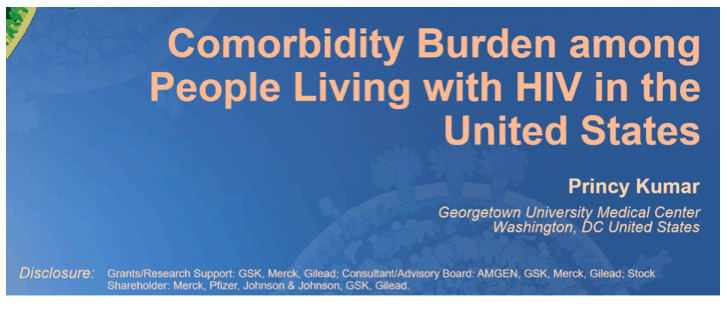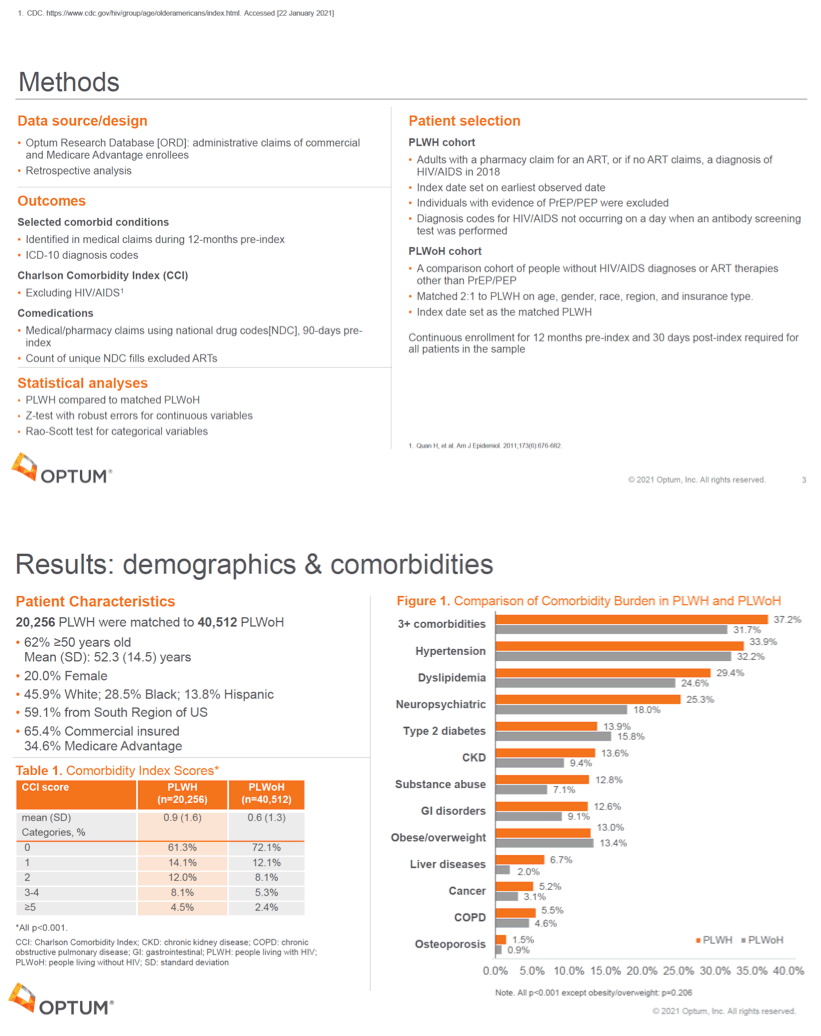 |
 |
 |
| |
COMORBIDITY BURDEN IN PEOPLE LIVING WITH HIV IN THE UNITED STATES
|
| |
| |
CROI 2021 March 6 Reported by Jules Levin
Misti L . Paudel1, Girish Prajapati2, Erin K. Buysman1, Swarnali Goswami2, Jianbin Mao2, Kimberly McNiff1, Princy N. Kumar3
1Optum, Eden Prairie, MN, USA, 2Merck & Co, Inc, Kenilworth, NJ, USA, 3Georgetown University Medical Center, Washington, DC, USA
Background: Antiretroviral (ARV) therapy is required life-long among people living with HIV (PLWH). It is important to understand the burden of comorbidities and comedications in PLWH to optimize clinical care.
Methods: Retrospective analyses of administrative claims data for commercial and Medicare Advantage enrollees from the Optum Research Database was conducted. PLWH cohort included adults (≥18 years) with ≥1 pharmacy claim for an ARV drug or HIV/AIDS diagnosis code in medical claims in 2018 calendar year (index date: earliest of pharmacy or HIV diagnosis claim date). Comparison cohort included adults without HIV (PLWoH), matched 2:1 with PLWH on age, gender, race, region and insurance type. Continuous health plan enrollment of 12 months (baseline) prior to, and 30 days (follow-up) after index date was required. Comorbidities were identified during baseline using ICD-9/10 diagnosis codes from medical claims. Charlson Comorbidity Index (CCI) was computed excluding HIV/AIDS. Baseline comedications were identified from pharmacy/medical claims using National Drug Codes.
Differences in PLWH vs PLWoH accounted for the matched design and used a Z-test with robust errors for continuous variables and Rao-Scott test for categorical variables.
Results: A total of 20,256 PLWH and 40,512 matched PLWoH were analyzed. The mean age was 52 years, 80% were male, 46% were White, and 59% resided in South. 17,694 (87%) PLWH received ARV treatment (NRTI=94%; InSTI=63%; NNRTI=29%; PI=17%). Hypertension was the most common comorbidity followed by dyslipidemia and neuropsychiatric conditions in both PLWH and PLWoH. Presence of ≥3 comorbidities (Figure 1), and mean CCI were higher in PLWH than PLWoH (0.93 vs 0.61, p<0.001), respectively. Most comorbid conditions were more prevalent among PLWH compared to PLWoH except obesity, type 2 diabetes mellitus, and autoimmune disorders which were more common in PLWoH (all p<0.01). Polypharmacy (≥5 medications) was more prevalent among PLWH vs PLWoH (84% vs 61%, p<0.001). The most prevalent non-ARV comedications in PLWH vs PLWoH were cardiovascular medications, 47% vs 42%; antidepressants, 27% vs 18%; and chronic antibiotics, 15% vs 7%; respectively (all p<0.001).
Conclusion: Multimorbidity and polypharmacy were more prevalent in PLWH compared to matched PLWoH. The study findings suggest the need for clinicians to consider comorbidities and comedications when selecting ARV regimens to minimize drug interactions and adverse events and thereby improve patient outcomes.




|
| |
|
 |
 |
|
|